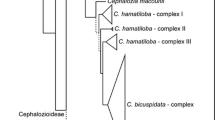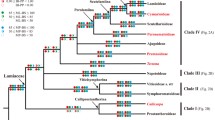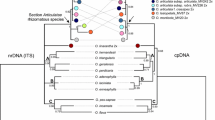Abstract
Cuscuta is a parasitic angiosperm that has been considered alternatively either as a genus within Convolvulaceae or as a monogeneric family in its own right. Although typically placed in the Solanales,Cuscuta has also been positioned within the Polemoniales. Extreme reduction of morphological and anatomical characters, as well as chloroplast genome reductions and rearrangements, has made the phylogenetic placement ofCuscuta uncertain. Analysis of 26S rDNA sequences suggests thatCuscuta is a derived member of Convolvulaceae. Molecular results are discussed in relation to the morphological and anatomical characters of autotrophic members of Convolvulaceae.
Similar content being viewed by others
Literature Cited
Britton N. L. &H. C. Brown. 1913. An illustrated flora of the northern United States and Canada, and the British possessions. Ed. 2. Scribner, New York.
Bömmer, D., G. Haberhausen &K. Zetsche. 1993. A large deletion in the plastid DNA of the holoparasitic flowering plantCuscuta reflexa concerning two ribosomal proteins, (rpl2, rpl23), one transfer RNA (trnI) and an ORF 2280 homologue. Curr. Genet. 24: 171–176.
Choisy, J. D.. 1841. De Convolvulaceis Dissertatio, etc. Mém. Soc. Phys. et d’Hist. Nat. Genève 9: 261–288.
Colewell, A. E. L.. 1994. Genome evolution in a nonphotosynthetic plant. Ph.D. dissertation. Washington University, St. Louis.
Cronquist, A.. 1968., The evolution and classification of flowering plants. Houghton Mifflin, Boston.
—. 1981. An integrated system of classification of flowering plants. Columbia University Press, New York.
—. 1988. The evolution and classification of flowering plants. Ed. 2. The New York Botanical Garden, Bronx.
Cullings, K. W. &T. D. Bruns. 1992. Phylogenetic origin of the Monotropoideae inferred from partial 28S ribosomal RNA gene sequences. Canad. J. Bot. 70: 1703–1708.
Dahlgren, A. M. T.. 1980. A revised system of classification of the angiosperms. Bot. J. Linn. Soc. 80: 91–124.
Dahlgren, G. D.. 1989. The last Dahlgrenogram. System of classification of the dicotyledons. Pages 249–260.In: K. Tan, editor. The Davis and Hedge Festschrift. University Press. Edinburgh.
dePamphilis, C. W.. 1995. Genes and genomes. Pages 177–205.In: M. C. Press & J. D. Graves, editors. Parasitic plants. Chapman & Hall, London.
Des Moulins, C. 1853. Etudes organiques sur les Cuscutes. Compt-Rend. de la XIX session (Toulouse) du Congrès Scientifique de France 2: 1–80.
Dodge, J. D. &G. B. Lawes. 1974. Plastid ultrastructure in some parasitic and semi-parasitic plants. Cytobiologie 9: 1–9.
Downie, S. R. &J. D. Palmer. 1992. Restriction site mapping of the chloroplast inverted repeat: a molecular phylogeny of the Asteridae. Ann. Missouri Bot. Gard. 79: 333–345.
Doyle, J. J. &J. L. Doyle. 1987. A rapid DNA isolation procedure for small quantities of fresh leaf tissue. Phytochem. Bull. 19: 11–15.
Engelmann, G.. 1887. The botanical works of the late George Engelmann. Wilson, Cambridge.
Felsenstein, J. 1978. Cases in which parsimony or compatibility methods will be positively misleading. Syst. Zool. 27: 401–410.
— 1985. Confidence limits on phylogenies: an approach using the bootstrap. Evolution 39: 783–791.
Freyer, R., K. Neckerman, R. M. Maier &H. Kössel. 1995. Structural and functional analysis of plastid genomes from parasitic plants: loss of an intron within the genusCuscuta. Curr. Genet. 27: 580–586.
Gray, A. 1908. New manual of botany. Ed. 7. American Book Company, New York.
Haberhausen, G. K. Valentin &K. Zetsche. 1992. Organization and sequence of photosynthetic genes from the plastid genome of the holoparasitic flowering plantCuscuta reflexa Molec. Gen. Genet. 232: 154–161.
— &K. Zetsche. 1994. Functional loss of allndh genes in an otherwise relatively unaltered plastid genome of the holoparasitic flowering plantCuscuta reflexa. Pl. Molec. Biol. 24: 217–222.
Hibbett, D. S. &R. Vilgalys. 1993. Phylogenetic relationships ofLentinus (Basidiomycotina) inferred from molecular and morphological characters. Syst. Bot. 18: 409–433.
Hooker, J. D., 1885. The flora of British India. L. Reeve. London.
Hutchinson, J. 1959. The families of flowering plants. Vol. I. Dicotyledons. Clarendon Press, Oxford.
Johri, M. &B. Tiagi. 1952. Floral morphology and seed formation inCuscuta reflexa Roxb. Phytomorphology 2: 162–180.
Kiss, T. M. Kiss &F. Solmosy. 1989. Nucleotide sequence of a 25S rRNA gene from tomato. Nucl. Acids Res. 17: 796.
Kuijt, J.. 1969. The biology of parasitic flowering plants. University of California Press, Berkeley.
Kuzoff, R. K. J. A. Sweere, D. E. Soltis, P. S. Soltis &E. A. Zimmer. 1998. The phylogenetic potential of entire 26S rDNA sequences in plants. Molec. Biol. Evol. 15: 251–263.
Lawrence, G. H. M.. 1951. Taxonomy of vascular plants. Maemillan, New York.
Machado, M. A. &K. Zetsche. 1990. A structural, functional and molecular analysis of plastids of the holoparasitesCuscuta reflexa andCuscuta europea. Planta 181: 91–96.
Maddison, W. P. &D. R. Maddison. 1992. Mac-Clade: analysis of phylogeny and character evolution. Version 3.0. Sinauer Associates. Sunderland, Massachusetts.
Metcalfe, C. R. &L. Chalk. 1950. Anatomy of the Dicotyledons. Vol. II. Clarendon Press, Oxford.
Michaels, H. J. K. M. Scott, R. G. Olmstead, T., Szaro, R. K. Jansen &J. D. Palmer. 1993. Interfamilial relationships of the Asteraceae: insights fromrbcL sequence variation. Ann. Missouri Bot. Gard. 80: 742–751.
Molau, U.. 1995. Reproductive ecology and biology. Pages. 141–176.In: M. C. Press & J. D. Graves, editors. Parasitic plants. Chapman & Hall, London.
Mullis, K. B. &F. A. Faloona. 1987. Specific synthesis of DNA in vitro via polymerase chain reaction. Meth. Enzymol. 155: 335–350.
Nickrent, D. L. &C. R. Franchina. 1990. Phylogenetic relationships of the Santalales and relatives. J. Molec. Evol. 31: 294–301.
—. 1994. High rates of nucleotide substitution in nuclear small-subunit (18S) rDNA from holoparasitic flowering plants. J. Molec. Evol. 39: 62–70.
—. 1996 Molecular studies of parasitic plants using ribosomal RNA. Pages 28–52.In: M. T. Moreno et al. editors. Advances in plant research, Junta de Andalucia. Dirección General de Investigación Agraria, Cordoba, Spain.
—,A. E. Colwell, A. D. Wolfe, N. D. Young, K. E. Steiner &C. dePamphilis. 1998. Molecular phylogenetic and evolutionary studies of parasitic plants. Pages 211–241.In: P. Soltis, D. Soltis & J. Doyle, editors. Molecular systematics of plants. Kluwer, Boston.
Olmstead, R. G., R. K. Jansen, H. J. Michaels, S. R. Downie &J. D. Palmer. 1990. Chloroplast DNA and phylogenetic studies in the Asteridae. Pages 119–134.In: S. Kawano, editor. Biological approaches and evolutionary trends in plants. Academic Press, London.
—,B. Bremmer, K. M. Scott &J. D. Palmer. 1992a. A parsimony analysis of the Asteridae sensu lato based onrbcL sequences. Ann. Missouri Bot. Gard. 80: 700–722.
—,H. J. Michaels, K. M. Scott &J. D. Palmer. 1992b. Monophyly of the Asteridae and identification of their major lineages inferred from DNA sequences ofrbcL. Ann. Missouri Bot. Gard. 79: 249–265.
Pérez-Amador, M. C., L. Arreola, J. Márquez-Guzmán &A. García-Argáez. 1996. Taxonomic markers of the family Convolvulaceae in four species ofCuscuta. Int. J. Exp. Bot. 58: 115–118.
Peter, A. 1897. Convolvulaceae. Pages 1–40.In: A. Engler & K. Prantl, editors Die natürlichen Pflanzenfamilien, IV, Teil 3. Abt. A. W. Engelmann.
Pfeiffer, M. 1846. Recherches sur les Cuscutacées. Ann. Sci. Nat. Ser. 3, 5: 83–89.
Press, M. C., J. D. Graves &G. R. Stewart. 1990. Physiology of the interaction of angiosperm parasites and their higher plant hosts. Pl. Cell Environm. 13: 91–104.
——. 1995. Parasitic plants. Chapman & Hall, London.
Rendle, A. B.. 1959. The classification of flowering plants. University Press, Cambridge.
Saiki, R. K., D. H. Gelfand, S. Stoffel, S. J. Scharf, R. Huiguchi, G. T. Horn, K. B. Mullis &H. A. Erlich. 1988. Primer-directed enzymatic amplification of DNA with thermostable DNA polymerase. Science 239: 487–491.
Sanderson, M. J.. 1989. Confidence limits on phylogenies. Cladistics 5: 113–129.
Searcy, D. G. 1970. Measurements by DNA hybridization in vitro of the genetic basis of parasitic reduction. Evolution 24: 207–219.
— &A. J. MacInnis. 1970. Measurements by DNA renaturation of the genetic basic of parasitic reduction. Evolution 24: 796–806.
Small, J. K. 1913. Flora of the southeastern United States. Ed. 2. Published by the author. New York.
Smith, B. F. 1934. A taxonomic and morphological study of the genusCuscuta, dodders, in North Carolina. J Elisha Mitchell Sci. Soc. 50: 283–302.
Soltis, D. F., P. S. Soltis, D. L. Nickrent, L. A. Johnson, W. J. Hahn, S. B. Hoot, J. A. Sweere, R. K. Kuzoff, K. A. Kron, M. W. Chase, S. M. Swenson, E. A. Zimmer, S. Chaw, L. J. Gillespie, W. J. Kress &K. J. Sytsma. 1997. Angiosperm phylogeny interred from 18S ribosomal DNA sequences. Ann Missouri Bot. Gard. 84: 1–19.
Stewart, G. R. &M. C. Press. 1990. The physiology and biochemistry of parasitic angiosperms. Annual Rev. Pl Physiol. Molec. Biol. 41: 127–151.
Sugiura, M., Y. Iida, K. Oono &F. Takaiwa. 1985. The complete nucleotide sequence of rice 25S rRNA gene. Gene 37: 255–259.
Swofford, D. L.. 1993. Phylogenetic analysis using parsimony. Illinois Natural History Survey, Champaign.
— &D. P. Beagle. 1993. Phylogenetic analysis using parsimony. Version 3.1.1. Illinois Natural History Survey. Champaign.
Takhtajan, A. L.. 1980. Outline of the classification of flowering plants (Magnoliophyta). Bot. Rev. (Lancaster) 46: 225–359.
— 1993. Diversity and classification of flowering plants. Columbia University Press, New York.
Thorne, R. F. 1983 Proposed new realignments in the angiosperms. Nordic. J. Bot. 3: 85–117.
Van Oostroom, S. J., (assisted by R. D. Hoogland). 1953. Convolvulaceae. Flora Males. Ser. 1, 4: 388–512.
Watson, L. & M. J. Dallwitz. 1992. The families of flowering plants: descriptions, illustrations, identification and information retrieval. URL: (http:// www.keil.ukans.edu/delta>.
Wettstein, R. 1935. Handbuch der systematischen Botanik. Franz Deuticke, Leipzig.
Yuncker, T. G.. 1921. Revision of the North American species ofCuscuta. Univ. Illinois Biol. Monogr. 6: 1–142.
— 1932 The genusCuscuta. Mem. Torrey Bot. Club 18: 113–331.
Author information
Authors and Affiliations
Rights and permissions
About this article
Cite this article
Neyland, R. A phylogeny inferred from large ribosomal subunit (26S) rDNA sequences suggests that Cuscuta is a derived member of Convolvulaceae. Brittonia 53, 108–115 (2001). https://doi.org/10.1007/BF02805402
Issue Date:
DOI: https://doi.org/10.1007/BF02805402




